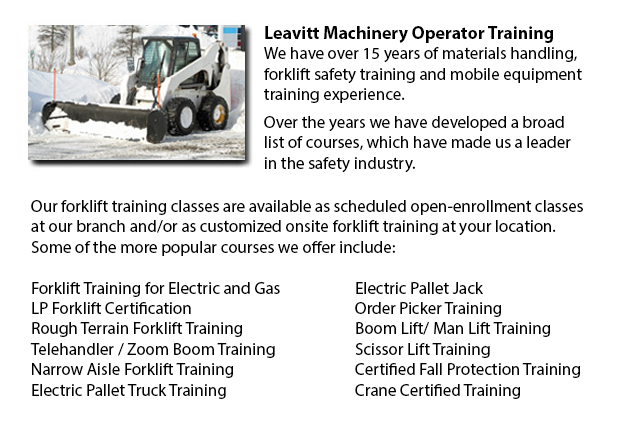
Skid Steer Ticket Whitby - On a skid-steer loader, the lift arms are alongside the driver along with pivot points at the rear of the driver's shoulders. This makes them different than a traditional front loader. Due to the operator's proximity to moving booms, early skid loaders were not as safe as conventional front loaders, especially through the operator's exit and entry. Today's' modern skid-steer loaders have many features to protect the driver like for example fully-enclosed cabs. Similar to other front loaders, the skid-steer model can push materials from one location to another, is capable of loading material into a truck or trailer and can carry material in its bucket.
Operation
There are various times where the skid-steer loader can be utilized in place of a large excavator on the job location for digging holes from within. To start, the loader digs a ramp to be used to excavate the material out of the hole. As the excavation deepens, the equipment reshapes the ramp making it steeper and longer. This is a particularly functional technique for digging under a building where there is not sufficient overhead clearance for the boom of a big excavator. For instance, this is a common scenario when digging a basement under an existing building or home.
The skid-steer loader accessories add much flexibility to the equipment. For example, traditional buckets on the loaders could be replaced attachments powered by their hydraulics including snow blades, cement mixers, pallet forks, backhoes, tree spades, sweepers and mowers. Some other popular specialized buckets and attachments comprise wheel saws, snow blades, trenchers, angle booms, dumping hopper, wood chipper machines, grapples, tillers and stump grinders rippers.
History
During the year 1957, the very first front-end, 3-wheeled loader was invented in Rothsay, Minnesota by brothers Cyril and Louis Keller. The brothers invented the loader in order to help a farmer mechanize the method of cleaning turkey manure from his barn. This particular machinery was compact and light and had a back caster wheel which allowed it to maneuver and turn around within its own length, allowing it to perform similar work as a conventional front-end loader.
The Melroe brothers of Melroe Manufacturing Company in Gwinner, N.D. bought in the year 1958, the rights to the Keller loader. The company then hired the Keller brothers to help with development of the loader. The M-200 Melroe was actually the end result of this particular partnership. This particular model was a self-propelled loader that was introduced to the market during 1958. The M-200 Melroe featured a a rear caster wheel, a 12.9 HP engine, a 750 lb lift capacity and two independent front drive wheels. By 1960, they changed the caster wheel along with a rear axle and introduced the very first 4 wheel skid steer loader that was referred to as the M-400.
The M-400 shortly became the Melroe Bobcat. Often the term "Bobcat" is used as a generic term for skid-steer loaders. The M-440 had an 1100 lb rated operating capacity and was powered by a 15.5 HP engine. The company continued the skid-steer development into the mid 1960s and introduced the M600 loader.
-
Wheel Loader Operator Training Whitby
Wheel Loader Operator Training Whitby - To be able to lift considerable loads, industrial cranes use levers and pulleys. In the past, Roman people used cranes to be able to erect large monuments making the origin of these equipment at least two thous... More -
Aerial Lift / Boom Lift / Man Lift / Scissor Lift Training in Whitby
Scissor lifts are lift truck tables which lift up materials and people and supplies vertically. They are normally utilized in commercial, industrial and construction environments. A common use of scissor lifts is for lifting or lowering construction... More -
Manlift Operator Training Whitby
Manlift Operator Training Whitby - A specialized kind of hydraulic platform is called an aerial lift or a man lift. It is intended to lift an individual vertically up and down and thus, is likewise known as a vertical personnel lift. This machinery i... More -
Aerial Lift Ticket Whitby
Aerial Lift Ticket Whitby - A boom truck is frequently recognized by the cable and telephone business vans that have the extended arm folded over their roofs. Commonly, a bucket-like apparatus sits at the extension of extendable arms. Often known as... More -
Crane Training Whitby
Crane Training Whitby - Overhead cranes are otherwise known as bridge cranes. They are a kind of crane which has a line and hook mechanism which runs along a horizontal beam which runs along two widely separated rails. Numerous overhead cranes could... More -
Forklift Certification Schools Whitby
Forklift Certification Schools Whitby - Within North America, forklift certification is mandatory, making forklift training programs essential for both the company and their employees working as operators of forklifts. Forklift training focuses on he... More -
Crane Safety Training Whitby
Crane Safety Training Whitby - Companies and crane drivers need to be aware of the issues connected to crane safety. Legislation provides rules for the safe operation, inspection and maintenance of lifting machinery all around North America. Crane Sa... More -
Overhead Crane Certification Whitby
Overhead Crane Certification Whitby - The overhead crane certification course is a course that is designed to assist trainees, even if they have literacy or language restrictions. The program consists of a classroom theory part and a practical hands-... More

Forklift Training Whitby
TOLL FREE: 1-888-254-6157
Whitby, Ontario
forklifttrainingwhitby.com
Email Us
About Us


